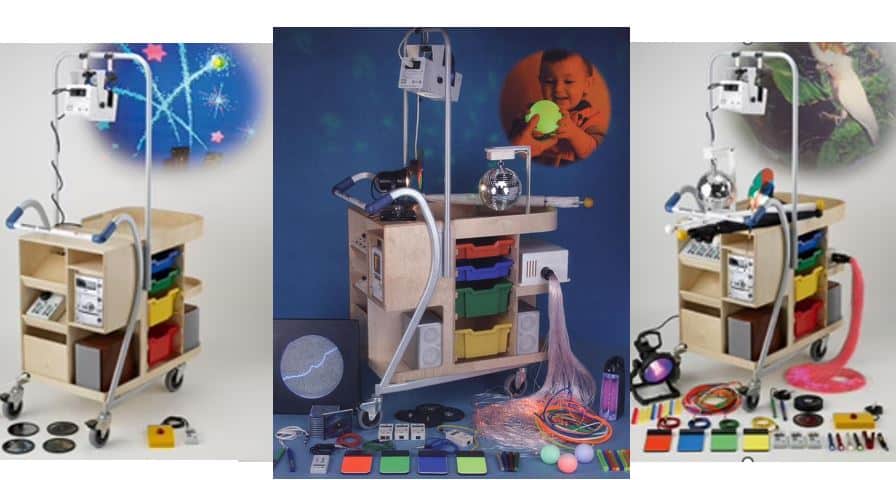
Creating a sensory space is becoming a fairly common practice in many public areas, especially ones that are catered to children. The ability to retreat to a space that is focused on sensory engagement can help both children and adults to manage difficult situations and work through their emotions in a safe environment.
While it’s often most common to dedicate a whole room or a piece of one to the creation of a sensory space, there are many situations where this just isn’t feasible. This is where sensory carts come in! These compact and portable units make having a sensory space possible, no matter how much room you have available.
Sensory carts, or trolleys, are transformative for institutions requiring the ability to take the therapeutic benefits of a sensory environment to patients or users. For schools, hospitals, eldercare facilities or even private homes. At SensoryOne, our sensory equipment specialists can customize a sensory cart to meet your needs.
Benefits of a Sensory Cart
Building a sensory cart isn’t a difficult task. There are many benefits to building one, even if it is being added to an already existing sensory room.
1. Portability
The most significant benefit to having a sensory cart is the fact that it is portable. A sensory space that can move around to wherever it is needed is helpful for any environment. Whether it gets moved from one school classroom to another, between exam rooms at a medical center or to different rooms at a seniors’ facility, a portable sensory cart is very convenient.
2. Adaptability
A portable sensory cart is designed to be adaptable to the needs of those using it. Whether you’re able to create a large cart packed with sensory items or are more restricted by space or budget, there are few limits when it comes to putting together an effective sensory cart.
3. Variety of sensory activities
Much like a sensory room, a sensory cart can include a wide variety of activities in order to be adaptable to anyone that will use it. From electronic features like an interactive projector or fibre optic lights to tactile experiences like kinetic sand or finger paints, a sensory cart can offer a unique experience for any user.
4. Small footprint
A sensory cart takes up considerably less room than most other sensory space options. It can be easily moved around from room to room, tucked in a corner for later use or put away for another day without taking up too much space. This means even the smallest places can benefit from a sensory cart.
Ready made or DIY?
Once you’ve decided that a sensory cart is the best option for your situation, the next question is whether you’d like to build it yourself or buy one that’s already made. The ability to create or buy a sensory cart that meets the specific needs of the people who will be using it helps maximize its value and effectiveness.
Ready made:
Buying a ready-made sensory cart that comes equipped with a variety of different sensory items takes a lot of the guesswork out of choosing the right activities. With a number of different done for you sensory cart options to choose from, you’ll be able to get one that suits your exact needs.
Create your own:
If you already have ideas of what you’d like to include on your sensory cart, putting together your own is a good choice. You can buy a cart that is already outfitted with a sound system and electronic connections and add the sensory items you’d like, or start completely from scratch. This method allows you to cater the cart to the setting in which it will be used.
Sensory carts are useful in a variety of settings
Much like a sensory room, sensory carts are very useful in a variety of different settings. Schools are the most common place to find a dedicated sensory space, however they are quickly appearing in a number of places. Sensory carts are the perfect tool for creating an immersive sensory experience in a setting that isn’t equipped for a dedicated room.
Hospitals, schools and day care centers, senior centers & programs, and doctors offices will all benefit from their use. A sensory cart can be used as a standalone sensory experience, or as an addition to a sensory room that is already in use. They are a great way to contain a number of different sensory tools in one central location, especially when you are short on space or want to move it around.



